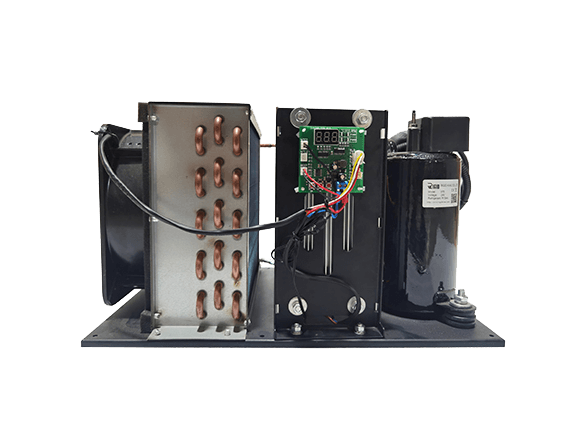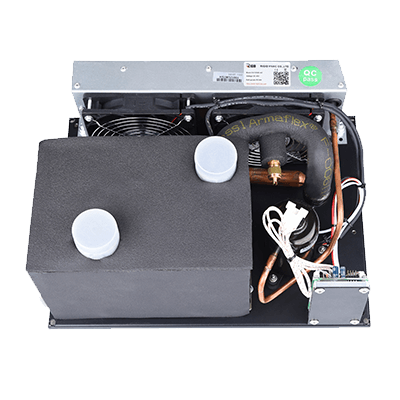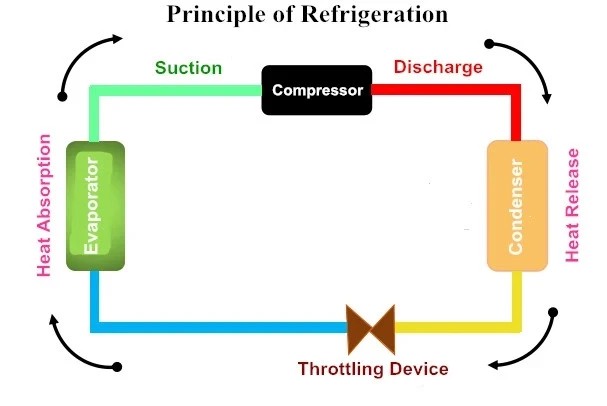Introduction

"Arctic Active Cooling. Endless Possibilities. We capture new technologies in mobile and compact cooling. Full-size cooling in a miniature design, customized to make your device stand out with innovative thermal management."
In our fast-paced world, access to cold water has become more essential than ever, making water dispensing technology a crucial element of modern convenience. Understanding how do water dispensers cool water can illuminate the science behind this everyday marvel. With effective cooling systems, these devices not only quench our thirst but also enhance our overall hydration experience.
Understanding Water Dispensing Technology
Water dispensers have evolved from simple jugs to sophisticated machines that serve chilled water at a moment's notice. At the heart of this technology lies an intricate cooling system designed to ensure that cold water is readily available whenever needed. So, how do water dispensers make cold water? The answer lies in their innovative refrigeration methods and efficient designs.
The Role of Effective Cooling
Effective cooling is paramount for any good water dispenser; without it, the refreshing experience of sipping chilled water would be lost. By utilizing advanced refrigeration techniques, these systems maintain optimal temperatures that keep the water crisp and enjoyable. This leads us to ponder: what is the cooling system of a water dispenser that allows it to perform so efficiently?
Importance of Cold Water Access
Cold water access plays a significant role in promoting hydration and overall health, especially in warmer climates or during physical activities. Whether it's for home use or in office settings, having quick access to chilled beverages can greatly improve user satisfaction and well-being. As we delve deeper into how do water coolers cool so fast, we will uncover the innovations that make cold drinking experiences possible.
How Do Water Dispensers Cool Water?

Water dispensers have become an essential appliance in homes and offices, providing easy access to cold water. But how do water dispensers cool water effectively? Understanding the cooling process is key to appreciating the technology behind these convenient devices.
Overview of the Cooling Process
At the heart of how do water dispensers cool water lies a fascinating process that transforms room temperature liquid into refreshing cold water. The cooling process typically involves circulating water through a system where it is chilled before being dispensed. This system ensures that users can enjoy cold beverages at any time, making it especially popular during warm weather.
To achieve this rapid cooling, most modern dispensers utilize either compressor-based systems or alternative methods like thermoelectric cooling. Each method has its own unique approach to lowering temperatures effectively and efficiently. By understanding these methods, we can better appreciate how do water dispensers make cold water available at our fingertips.
The Magic of Refrigeration Technology
The magic behind how do water coolers cool so fast lies in refrigeration technology, which has revolutionized the way we think about temperature control in appliances. Refrigeration works by removing heat from an area and expelling it elsewhere, creating a cooler environment for the liquid inside the dispenser. This technology not only allows for quick cooling but also ensures that the desired temperature is maintained consistently over time.
Refrigeration technology relies on various components working in harmony to achieve optimal performance. For instance, compressors play a crucial role by compressing refrigerants and circulating them throughout the system to absorb heat from the surrounding environment. This intricate dance of components is what makes understanding what is the cooling system of a water dispenser so fascinating.
The Role of Refrigerants in Cooling
Refrigerants are indispensable when discussing how does a water cooler work; they are responsible for absorbing heat from the liquid being cooled and transferring it away efficiently. These substances change states between gas and liquid as they circulate through the system, enabling effective heat exchange without losing energy or efficiency in the process.
In many modern systems, refrigerants like R134a are utilized due to their excellent thermal properties and lower environmental impact compared to older options like Freon. Understanding what cools the water in a water cooler helps highlight why selecting appropriate refrigerants is vital for both performance and sustainability in today's eco-conscious market.
What is the Cooling System of Water Dispenser?

Understanding what cools the water in a water cooler is essential for appreciating how these devices function. Water dispensers utilize various cooling systems to provide refreshing cold water on demand. This section dives into the types of cooling systems, compares compressor and non-compressor models, and highlights key components that make these systems tick.
Types of Cooling Systems Explained
When exploring how do water dispensers cool water, it’s crucial to know that there are two primary types of cooling systems: compressor-based and non-compressor systems. Compressor models are more traditional and rely on refrigerants to absorb heat from the water, while non-compressor options use alternative methods like thermoelectric cooling or passive cooling techniques. Each system has its merits depending on user needs, space constraints, and efficiency requirements.
For instance, compressor-based systems typically provide colder water faster than their non-compressor counterparts due to their ability to reach lower temperatures quickly. Conversely, non-compressor models may be quieter and more energy-efficient but often struggle with rapid temperature drops when compared directly with compressors. Understanding these distinctions helps consumers make informed choices about what is best for their cold water access needs.
Comparing Compressor and Non-Compressor Models
In the world of water dispensers, knowing how do water dispensers make cold water can lead you to choose between compressor and non-compressor models effectively. Compressor models generally feature a refrigeration cycle that includes a condenser, evaporator, and refrigerant gas—this allows them to chill large amounts of water efficiently. On the other hand, non-compressor options often utilize thermoelectric plates which rely on electricity for direct heating or cooling without moving parts.
While compressor units can chill large volumes quickly—making them ideal for high-demand environments—non-compressor units tend to be smaller and less expensive upfront but may have limitations in terms of output capacity. The choice depends largely on your specific needs: if you're entertaining guests frequently or need quick access during hot days, a compressor model might be your best bet; however, if you want something compact for occasional use at home or in small offices, a non-compressor could suffice.
Key Components of Water Cooler Systems
To fully grasp what is the cooling system of a water dispenser involves understanding its key components that work together seamlessly for optimal performance. The main elements include the refrigeration unit (compressor), condenser coils where heat exchange occurs, evaporator coils where cold air is generated, along with various valves and controls that regulate the flow of refrigerant throughout the system.
In advanced designs like Arctic Active Cooling's Mini Water Chiller—featuring an efficient mini compressor with R134a coolant—you’ll find sophisticated integration that not only simplifies installation but also enhances overall performance by allowing users greater control over their chilling process through customizable settings via their control boards. This level of precision ensures users get exactly what they want when asking how do water coolers cool so fast; it’s all about efficient design working harmoniously together!
As we dive deeper into understanding how does a water cooler work at its core mechanics level in subsequent sections, it's evident that each component plays a pivotal role in delivering refreshing cold beverages right when you need them most.
How Do Water Coolers Cool So Fast?

Water coolers have become essential appliances in homes and offices, primarily due to their ability to provide refreshing cold water on demand. But how do water dispensers cool water so efficiently? Understanding the rapid cooling mechanisms, the significance of temperature differentials, and the latest innovations in chilling technologies can shed light on this fascinating process.
Rapid Cooling Mechanisms
At the heart of how do water dispensers make cold water is the rapid cooling mechanism that many modern units utilize. These systems often employ refrigeration technology that quickly lowers the temperature of incoming water, allowing it to be dispensed at just the right chill. For instance, compressor-based models use a cycle of compression and evaporation to absorb heat from the water, resulting in a swift drop in temperature.
The process begins when warm water enters the cooler; it passes through a series of coils where refrigerants absorb heat. This efficient transfer not only cools down the water rapidly but also ensures that users enjoy ice-cold refreshment with minimal wait time. The effectiveness of these rapid cooling mechanisms is what makes many consumers wonder: what cools the water in a water cooler?
The Impact of Temperature Differential
Another key factor contributing to how do water coolers cool so fast is the impact of temperature differential. When warm ambient air comes into contact with chilled surfaces within a cooler, heat naturally flows from warmer areas to cooler ones. This principle allows for quick heat exchange processes that enhance overall cooling efficiency.
In practical terms, this means that as soon as you refill your dispenser with room-temperature or warm tap water, it can be cooled down rapidly because there’s a significant temperature difference between incoming and existing chilled water. This phenomenon not only accelerates cooling but also optimizes energy consumption by reducing compressor run times—making your unit more eco-friendly while delivering icy beverages at speed.
Innovations in Water Chilling Technologies
The world of refrigeration isn't stagnant; innovations are continuously reshaping how we think about cooling systems for dispensers and other appliances alike. One standout example is Arctic Active Cooling's Mini Water Chiller, which offers an advanced refrigeration mini compressor equipped with R134a coolant—a compact solution designed for high efficiency without compromising performance.
This cutting-edge technology integrates various components such as condensers and evaporators into one sophisticated unit, simplifying installation while providing end users with state-of-the-art micro cooling solutions tailored for specific needs. Customers who desire flexibility can easily integrate these modules into their existing setups—perfectly illustrating how modern advancements are revolutionizing what we know about how does a water cooler work efficiently today.
What Cools the Water in a Water Cooler?

Exploring Refrigeration Methods
One of the most common methods used in how do water dispensers make cold water is through vapor-compression refrigeration. This method involves a refrigerant that evaporates and absorbs heat from the surrounding environment before being compressed back into a liquid state. The cycle continues, effectively removing heat from the water and maintaining its cold temperature, making it an efficient solution for your hydration needs.
Another fascinating approach is the use of thermoelectric cooling, which employs semiconductor devices to create a temperature differential between two sides of a unit. This technology may not be as prevalent as traditional compressor systems but offers unique advantages in specific applications where noise levels need to be minimized or space is limited. Understanding these refrigeration methods can help consumers make informed decisions about what is the cooling system of their water dispenser.
Role of Heat Exchangers
Heat exchangers play a pivotal role in how do water coolers cool so fast by facilitating rapid heat transfer between the incoming warm water and the refrigerant within the system. These components are designed to maximize surface area contact, allowing for efficient energy exchange without mixing fluids—an essential feature for maintaining clean drinking water while achieving optimal cooling performance.
In many modern designs, such as those incorporating Arctic Active Cooling's Mini Water Chiller, advanced heat exchanger technology is integrated with other refrigeration parts like condensers and evaporators for enhanced efficiency. The sophisticated design ensures that users benefit from quick chilling capabilities while keeping installation processes straightforward—perfect for those looking to understand what cools the water in a water cooler without unnecessary complexity.
Importance of Thermodynamics in Cooling
The principles of thermodynamics are at play whenever we ask ourselves how does a water cooler work effectively to provide cold beverages on demand. Essentially, these laws govern how energy transfers occur within closed systems like those found in dispensers; they dictate how efficiently heat can be removed from one medium (the warm incoming water) and transferred away (to the refrigerant).
By leveraging these thermodynamic principles through innovative designs such as Arctic Active Cooling's products—featuring high-efficient mini compressors—the entire process becomes streamlined for optimal performance while minimizing energy consumption. Understanding this relationship helps users appreciate not just what cools their drinking supply but also why choosing an efficient model pays off both environmentally and economically.
How Does a Water Cooler Work?

Understanding the inner workings of a water cooler is crucial for appreciating how these devices provide refreshing cold water on demand. So, how do water dispensers cool water? By employing a combination of advanced refrigeration technology and efficient design, water coolers deliver chilled water quickly and effectively. In this section, we will explore the step-by-step functionality of these machines, delve into the innovative Arctic Active Cooling system, and share essential maintenance tips to ensure optimal performance.
Step-by-Step Breakdown of Functionality
To grasp how does a water cooler work, it's helpful to break down its functionality into manageable steps. First, the unit draws in ambient temperature water from a reservoir or bottle. Next, this water passes through a cooling system that often employs refrigeration methods to lower its temperature rapidly—this is where the magic happens! The cooled water is then stored in a designated compartment until you press that satisfying lever or button for your refreshment.
As we explore further into what cools the water in a water cooler, it becomes evident that both compressor-based and non-compressor models utilize different mechanisms for achieving cold temperatures. Compressor models typically use refrigerants that absorb heat from the incoming water while releasing it outside through coils. Non-compressor models may rely on thermoelectric cooling systems that use electricity to create temperature differentials instead.
In terms of speed, you might wonder: how do water coolers cool so fast? The efficiency lies in their design; they are engineered to maximize surface area for heat exchange and minimize thermal loss during operation. This synergy between components ensures you get ice-cold hydration without having to wait long!
The Integration of Arctic Active Cooling
One standout innovation in modern cooling technology is Arctic Active Cooling's Mini Water Chiller. This compact system features an efficient refrigeration mini compressor using R134a coolant along with other integrated components like condensers and evaporators—all designed with sophisticated engineering precision. By incorporating such advanced tech into their units, Arctic Active Cooling not only simplifies installation but also enhances performance significantly.
So how do water dispensers make cold water with systems like this? The Mini Water Chiller allows customers who prefer customization to integrate or assemble their own cooling subsystems seamlessly with existing equipment or machinery. With options for controlling compressor speed via your control board, users can optimize performance according to their specific needs.
This level of adaptability is perfect for those seeking innovative solutions while keeping up-to-date with micro-cooling technologies! Whether you're running an office or catering business, understanding what goes into your cooling system can help you appreciate its value even more.
Maintenance Tips for Optimal Performance
To ensure your unit continues functioning at peak efficiency—after all, no one wants lukewarm refreshments—consider some essential maintenance tips! Regularly check and clean filters as they can become clogged over time; this simple step ensures smooth airflow which is vital for effective cooling performance.
Additionally, keep an eye on any signs indicating issues within the cooling system itself—like unusual noises or inconsistent temperatures—that might suggest it's time for professional servicing or repairs. Understanding what is the cooling system of your dispenser can empower you as an owner; being proactive about maintenance will prolong its lifespan significantly!
Lastly, don't forget about cleanliness! Regularly sanitize reservoirs and taps not just because it’s good hygiene but also because clean surfaces contribute positively towards maintaining optimal functionality over time.
Conclusion

As we wrap up our exploration of water dispensing technology, it's clear that understanding how do water dispensers cool water is crucial for appreciating their role in our daily lives. The advancements in cooling systems have turned a simple need for cold water into a sophisticated process that combines science and engineering. With the ongoing evolution of these technologies, we can expect even more efficient and innovative solutions in the future.
The Future of Water Dispenser Technology
The future of water dispenser technology looks promising, with innovations aimed at enhancing efficiency and user experience. As we delve deeper into how do water dispensers make cold water, it's evident that emerging technologies will likely introduce smarter cooling systems that optimize energy consumption while delivering chilled refreshment faster than ever before. This could include advancements like Arctic Active Cooling's Mini Water Chiller, which integrates high-efficiency components to ensure rapid cooling and seamless installation.
Enhancing User Experience with Efficient Cooling
Efficient cooling not only improves performance but also significantly enhances user experience when it comes to accessing cold beverages. Understanding what cools the water in a water cooler allows consumers to appreciate the intricate design behind their favorite appliances. By focusing on how do water coolers cool so fast through innovations such as advanced refrigerants and heat exchangers, manufacturers can provide users with an instant gratification moment whenever they reach for a glass of ice-cold water.
Making Informed Choices for Water Coolers
Consumers should consider various factors such as the type of compressor used, maintenance requirements, and overall efficiency ratings. By being informed about how does a water cooler work and evaluating different models based on their unique features, buyers can make choices that align with their needs while ensuring they enjoy refreshing cold drinks without any hassle.
